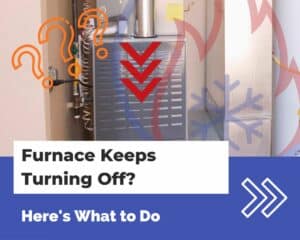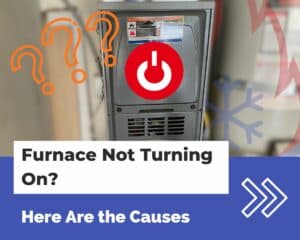As far as safety is concerned, the exhaust pipe is one of the most important parts of a furnace. Why is that?
The exhaust pipe is responsible for removing poisonous flue gases from your furnace. If the exhaust pipe is blocked or broken, harmful gases can get into your home’s air.
In this article, I’ll explain what a furnace’s exhaust pipe is for. I’ll also discuss what factors you need to consider when venting a furnace, and how to identify a furnace by its exhaust pipe.
How does the furnace exhaust pipe work?
When your furnace burns gas, it creates heat, water vapor, and carbon dioxide. As part of the combustion process, by-products are produced: Nitrogen oxides, sulfur oxides, and most notably—carbon monoxide (CO).
The exhaust pipe’s job is to remove these harmful gases from your home and vent them outside.
How does the exhaust pipe remove flue gases from your furnace?
The exhaust pipe is attached to the inducer fan. The inducer fan creates a draft through your furnace’s combustion chamber and heat exchanger. As the gas undergoes combustion, the flue gases flow through the heat exchanger and exhaust pipe. The flue gases exit the exhaust pipe and get dumped outside your home.
Where is the furnace exhaust vent located?
Your furnace’s exhaust vent is located on the outside of your home.
If you have a standard-efficiency furnace, then your exhaust vent should be located on the roof.
If you have a high-efficiency furnace, then your exhaust vent should be located on the roof or on the side of your home.
Why does the location of the exhaust vent differ between standard and high-efficiency furnaces?
It’s due to the contents of the furnace exhaust.
In standard-efficiency furnaces, the exhaust contains hot gases. Because of the high temperature of the exhaust, the gases naturally draft up. This is why the exhaust vent for a standard-efficiency furnace is located on the roof of the home.
In high-efficiency furnaces, the exhaust contains mostly water and carbon dioxide. The exhaust from a high-efficiency furnace is not hot enough to rise up on its own. Instead, an inducer fan is used to push the exhaust out of the house through a venting pipe.
High efficiency (condensing) furnace venting
Venting for high-efficiency condensing furnaces is a complicated topic since there are many factors at play. Especially if you’re retrofitting a high-efficiency furnace into an older home.
There are two types of high-efficiency furnace venting setups: single-pipe and two-pipe. Both have their pros and cons. The one that is best for your home depends on a myriad of factors:
- Availability of existing venting systems to use as a chase
- Local government codes and homeowner association rules
- Location of the furnace in your home
- Venting setup of other appliances
- Airtightness of home
For more information about venting a high-efficiency furnace, check out my article below:
What if you have PVC furnace intake and exhaust pipes?
If you have PVC intake and exhaust pipes for your furnace, then you have a high-efficiency furnace.
Why are PVC pipes needed for high-efficiency furnaces?
PVC pipes are needed for high-efficiency furnaces due to the contents of the furnace’s exhaust.
Exhaust from high-efficiency furnaces contains acidic water. The acidic water will corrode metal exhaust pipes quickly. PVC does not corrode, so PVC pipes are used instead.
Furnace PVC exhaust pipe condensation
If you have a high-efficiency furnace, then its PVC exhaust pipes will need to be sloped towards the furnace.
Specifically, most installations require a minimum of ¼” of slope per foot of pipe. This allows the furnace condensate to flow back towards the furnace’s drain pipe. This keeps the furnace’s condensate contained inside your furnace’s drainage system.
Why can’t the furnace condensate be drained outside?
There are two reasons why furnace condensate shouldn’t be drained outside:
- If the condensate flows outside, then it may freeze if outdoor temperatures get too low. Frozen condensate can break your PVC exhaust piping.
- Some areas don’t allow you to drain furnace condensate onto the ground because its acidity may pollute the groundwater.
What if you have a metal furnace exhaust pipe?
If your furnace’s exhaust pipe is made out of metal, then you have a standard-efficiency furnace.
Why are metal exhaust pipes needed for standard efficiency furnaces?
Metal pipes are needed for standard efficiency furnaces due to the high temperature of the exhaust.
How hot is gas furnace exhaust?
Exhaust temperatures from standard efficiency furnaces are usually in the 300-400° F range. The exhaust gases from a standard-efficiency furnace are hot enough to melt a PVC pipe. That’s why standard-efficiency furnaces use metal exhaust pipes.
Do you need a gas furnace exhaust fan?
Almost all furnace exhaust systems use an exhaust fan to push the flue gases outside. An exhaust fan for furnace flue gases is called an inducer. The inducer is built into the furnace and turns on whenever the furnace heats your home.
Some older furnaces use a natural draft system to expel flue gases from the home. In a natural draft furnace, there is no inducer fan. Instead, the hot flue gases naturally flow upwards out of the home through a flue pipe or chimney.
If you have an older natural draft furnace, you probably don’t need an exhaust fan. Natural draft furnaces are installed in such a way that does not require an exhaust fan for the flue gases.
If you have a newer furnace then your furnace will have an inducer fan built into it. So there’s no need to install a separate exhaust fan.




I have a standard efficiency furnace with metal exhaust piping and have a condensation problem with water dripping into my fireplace in the winter when it is not raining
Hi Pat,
Standard efficiency furnace condensate can be caused by an improperly sized exhaust pipe or combustion issues. Either way, it’s a serious issue and you should turn off your furnace and get it checked out by an HVAC professional ASAP.
-Trey
I have a high effiency furnace using black pvc pipe and had my furnace tech installing a digital thermostat told me it should be white pvc because the black one will crack over time ,is this true
Hi Dwayne,
The color of the pipe does not matter.
However, there’s a good chance that the “black PVC pipe” installed on your furnace is actually ABS pipe. Certain types of ABS pipe can be used for furnace venting in some areas. It depends on your local codes.
Some older types of ABS pipes were known for cracking. However, the newer types of ABS don’t have the same issues, as long as they are made for venting purposes.
Hope this helps,
-Trey
I have a high efficiency propane furnace (not natural gas) and I have two pipes coming out of the roof. The fresh air intake pipe is about 1 1/2 feet shorter than the exhaust pipe and has an elbow on top facing away from the exhaust pipe. For the second time, I have smelled furnace exhaust in my house. I have had to open the doors to clear the air. I have kept the snow away from the pipes. (our snow is measured in feet). Is it possible that, depending on the barometric pressure, the heavier exhaust gas is floating down and getting sucked into the fresh air intake pipe? My furnace is about three years old and this has only occurred twice.
Hi Sharon,
I’m not sure if your “fresh air intake pipe” is for fresh outside air for your home or furnace combustion air. Either way, you should not be smelling furnace exhaust in your home. I recommend getting an HVAC professional to take a look at your system.
Hope this helps,
-Trey
I had a new high efficiency furnace with a concentric pic exhaust pipe/air intake set up installed last winter. We had no problems last winter. This year we are hearing loud knocking noises where within 1 foot of where the pipe leaves the side of the house, We’ve been told by several heating contractors that they have never heard of such a thing, but could be the pic pipe expanding and contracting. So far no one has come up with a solution to get rid of the knocking. Any thoughts.
Hi Linda,
My guess is that the PVC pipe is expanding into the side of your house when it heats up.
If there isn’t enough clearance between the pipe and the hole that it goes through, the pipe will sometimes make popping noises as it expands and rubs up against the side of the hole.
My recommendation would be to ensure that the pipe moves freely through the hole and has a gap around it to account for thermal expansion.
Hope this helps,
-Trey
Hello
I have a 3 yrs old house with high efficiency furnace (with a concentric pic exhaust pipe/air intake set up). Staring last year,
drifting snow and/or ice formation block the exhaust or intake pipe or both and cause the furnace to go into safety lockout mode and shut down automatically. Usually I clean (couple of times, in the middle of the night) the exhaust/intake pipe/vents outside & the furnace starts to work again. My questions why this happens? is this normal problem? is the issue with the way the pipes installed or the fan inside the furnace or what?
Thank you
Hi Ephrem,
Your issue seems to be the location of the intake/exhaust vent. I recommend getting a local HVAC professional to check out your system to see what can be done to fix it.
Hope this helps,
-Trey
Elbow up the pipes past the area of 100 year snowfall heights then screen and rain cap on the exhaust and fresh air intake. Run the exhaust higher than the fresh air to avoid coming ling the two. The hot air rises always.
what is the purpose of the round topper on the furnace vent on the roof and does it need to have one?
Hi Al,
Great question. The roof vent cap is needed to protect the interior of the exhaust pipe and prevent debris from getting inside of the furnace’s exhaust venting system.
Hope this helps,
-Trey
I have a HE Trane gas furnace with two long pipes (about 40 feet) vented through the side of the house. My furnace is shutting down after a few minutes and I have isolated the trigger to the flame rollout sensor. I’ve read that an exhaust obstruction could lead to improper combustion and cause this sensor to trip. The PVC exhaust piping is all tightly glued together and clamped down. Do I need to start cutting to gain access to clean it? I tried suction with a large shop vacuum at the exhaust end but I don’t think it provided enough vacuum to overcome the long run of slightly upward tilting pipe.
Hi Roger,
That’s a tricky problem. I recommend calling a professional to check it out so you don’t go down the wrong path.
A new furnace was installed, the new vent pipe was installed on top of the old one , so it’s twice as tall. On strong windy days , I hear a load whistling sound. why?
Hi Bill,
That could be the top of the vent pipe whistling from the wind. I would get it checked out to make sure there aren’t any other problems. If no other problems, you can also install a vent hood over the top if it keeps whistling as long as it doesn’t restrict the flow of exhaust from the vent pipe.
-Trey
A high wind exhaust cap is needed.
I’ve had occasional high press switch error codes on my Rheem 95 pct. RGFD that trip the burner from lighting. I can’t find any obstruction and I changed the high press switch. The oval metal capacitor on the inducer motor is very rusty. I bought a new one, but I can see no +/- markings on either the old one or the new one. Is the capacitor non electrolytic/non polarized, or is the motor AC, so that it doesn’t matter which wire connects to which capacitor terminal?
Thanks.
Hi Mike,
I’m assuming that you have a run capacitor with two terminals. If that’s the case then you’re correct – it doesn’t matter which wire connects to which terminal.
-Trey
Hello Trey
I had a new HE furnace installed 5 years ago. My contractor re used the old exhaust pipe (at least the part that extends above the roof). Since I got the new system, my gas usage is higher by 20-30%. Could ventilation be my problem?
Paul
Hi Paul,
There are all sorts of factors that could be the problem, ventiliation is just one of them. Get a diagnosis from a different company to see whether the increased gas usage is normal or not.
I have a standard furnace with a metal vent pipe. I had a leak at the vent pipe and boot connection which I caulked. Later I found out the caulk is only good to 200°, will that be a problem for fire or will it just fail. The product is flammable before it cures it has mineral spirits in the product.
Hi Sam,
Furnace exhaust vents should be sealed with high-temperature silicone caulk
-Trey
I have a 80% efficiency furnace that was just installed by professionals. They came back and put skirts around the holes they made for the exhaust vent duct work except in one place. I was thinking about using expandable foam around that area to seal it up. The foam (MSDS sheet) says its good for up to 194* F as a service temperature
and the wall that this area pertains to (that is exposed) is about 3 feet away from the actual furnace flame. Is the only way to know for sure whether this would be an ok idea to fire up the furnace and measure the ductwork in that area with a digital thermometer ?
Hi Kevin,
You should check with the furnace installers if there was a reason why did not put skirts around that particular hole – there could be a reason they left it that way.
-Trey
Morning,
I recently had a Goodman 80% furnace installed and I noticed that a rubber boot came with the furnace for the exhaust vent connection at the furnace itself. This boot obviously gets hot when the furnace is running. Should there be a different type of connection there from the furnace to the vent pipe? Or does the rubber boot with hose clamps provided suffice? Thanks.
Hi James,
It depends on the type of exhaust venting that was used and the building codes in your local jurisdiction. If you are worried you can contact your local building inspector’s office since they will know what is allowed.
Hope this helps,
-Trey
Can a high efficiency furnace have too much slope on the exhaust PVC?
meaning slanted at say 45 degree angle
Hi Max,
Generally you can’t have too much slope, only too little slope. However, you should consult with the local codes in your area to see if your specific venting setup follows the requirements.
-Trey
Hi,
Just replaced an old furnace with Trance high efficiency, the exhaust pipe run through the outside but the air intake pipe is inside just 3 inches long on top of the furnace. Is this a safe installation?
Hi Wil,
The safety of that installation depends on a lot of factors. One place to start is to check the building codes in your area, that will govern what is considered a correct and safe installation.
-Trey
Hey,
I it seems I have a high efficiency furnace (PVC flue vented on the side of the house) and my furnace keeps tripping the high limit switch every 6 minutes on the dot. It stays off for 3 minutes with the blower still blowing air then turns back on and the cycle repeats forever. I was wondering is it possible that the switch is just faulty and opening too soon? It doesn’t seem to me I have a restriction on any of my vents the air seems to flow good on every vent. Is there anything else I can do to find the cause?
Hi Andrey,
High limit switch tripping is usually due to airflow issues. It is possible that the switch itself is bad, that does happen from time to time.
Here is my article on high limit switch tripping if you need more info: https://hvactrainingshop.com/furnace-high-limit-switch-tripping/
-Trey
I do have a high-efficiency furnace 2 PVC pipe system. I live in Wisconsin freezing temps for winter. I know that my exhaust pipe is NOT pitched 1/4″ per foot toward the furnace. If I have the exhaust pipe is turned up outside the house, and the intake down the exhaust does freeze. Could I drill say a 3/8″ hole in the elbow to help drain the water. And is this setup for directions of the pipes correct for the area?
Hi Wayne,
You should refer to the local codes in your area first. However, generally speaking you should probably look into having the pipe pitch corrected so your exhaust pipe can self-drain correctly.
-Trey
hi Trey,
i have a Rudd high efficiency furnace mounted in our crawlspace at our cottage. it was installed in 2011, we have since done a remodel. the new contractor had to extend the current exhaust and intake pipes as we added on to the side of the cottage where they were vented. when it was installed in 2011 the contractor separated the intake and exhaust pipes by making the distance in height of pipes about 12 inches.which is code to separate the pipes. when the new contractor extended the new pipes they brought the exhaust and intake pipes at the same height and just put elbow fittings on the end. i am concerned about this as it could be a health hazard pulling exhaust air back in the intake pipe, the contractor tells me this is code now can you tell me what you think. thank you Dennis
Hi Dennis,
I’m not sure of the codes in your area, you’ll need to check on them
-Trey
I have a high efficiency furnace. During the spring a bird made a nest inside the flue from the roof of the house. I had the furnace guy out today he removed the nest from inside the flue inside the house. Is there a screen I can purchase to put over the top so birds don’t try to build a nest again. If so what is it called? And what size is it? Is it dangerous to block it with a screen?
Hi Carol,
Generally, it’s okay to put a screen over the furnace flue as long as it has large holes that don’t impede airflow. However, you should check with the local codes in your area to ensure that a screen on the furnace flue is okay.
-Trey
I have a crown boiler, with steel pipe that was coming out of the basement wall pitched to a 45 degree angle. I recently had some work done to wall outside for cosmetic purposes and the workers, added an elbow to the outside vent pipe so that the hot air moves away from the wall. Will this affect the boiler function?
Hi Marker,
You’ll need an HVAC technician to look at your specific setup to know whether that added elbow is affecting how your boiler functions.
-Trey
can you tie the intake and exhaust pipe on a he gas furnace together before it exits the house? I was told it just preheats the incoming air to the furnace.
Hi Bill,
I think what you’re referring to is a concentric exhaust pipe. Yes they can be used. In addition to preheating the air, they allow for only one roof/wall penetration to be made instead of two.
I’m having issues with my high efficiency furnace burners not staying on. The issue started when it got really cold here two days ago. The temperatures have been from -20 to -5 degrees Fahrenheit for the highs. The furnace flames fire up and then go out between 5-45 seconds after that. It’ll try to light 3 times before it’ll shut off. I checked and cleaned the flame sensor. I removed the flame sensor and it won’t stay lite for more than 3 seconds when I do that. So, I don’t think the sensor is the issue. Can the outside cold temperatures be causing it not to vent correctly? My furnace vent is pvc and vents out the side of the house. I’ve check for obstructions and there are none.
Hi Justin,
What kind of error code is your furnace showing after it tries to turn on?